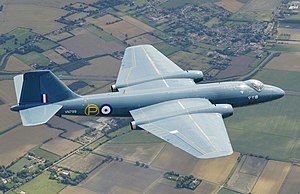
Back English Electric Canberra Afrikaans English Electric Canberra AN إنجلش إلكتريك كانبيرا Arabic English Electric Canberra Czech English Electric Canberra German English Electric Canberra Spanish انگلیش الکتریک کانبرا Persian English Electric Canberra Finnish English Electric Canberra French English Electric Canberra Galician
| Canberra | |
|---|---|

| |
| Canberra T.4 WJ874 in 2005. It had been painted in 1999 to represent the first prototype VN799, first flown in 1949. | |
| Role | Bomber/Reconnaissance |
| National origin | United Kingdom |
| Manufacturer | English Electric |
| First flight | 13 May 1949 |
| Introduction | 25 May 1951 |
| Retired | 23 June 2006 (RAF), 11 May 2007 (IAF) |
| Status | Retired |
| Primary users | Royal Air Force |
| Number built | |
| Developed into | Martin B-57 Canberra |
The English Electric Canberra is a British first-generation, jet-powered medium bomber. It was developed by English Electric during the mid- to late 1940s in response to a 1944 Air Ministry requirement for a successor to the wartime de Havilland Mosquito fast bomber. Among the performance requirements for the type was an outstanding high-altitude bombing capability and high speed. These were partly accomplished by making use of newly developed jet-propulsion technology. When the Canberra was introduced to service with the Royal Air Force (RAF), the type's first operator, in May 1951, it became the service's first jet-powered bomber.
In February 1951, a Canberra set another world record when it became the first jet aircraft to make a nonstop transatlantic flight. Throughout most of the 1950s, the Canberra could fly at a higher altitude than any other aircraft in the world, and in 1957, a Canberra established a world altitude record of 70,310 feet (21,430 m). Due to its ability to evade the early jet interceptor aircraft, and its significant performance advancement over contemporary piston-engined bombers, the Canberra became a popular aircraft on the export market, being procured for service in the air forces of many nations both inside and outside of the Commonwealth of Nations. The type was also licence-produced in Australia by Government Aircraft Factories (GAF) and in the US by Martin as the B-57 Canberra. The latter produced both the slightly modified B-57A Canberra and the significantly updated B-57B.
In addition to being a tactical nuclear strike aircraft, the Canberra proved to be highly adaptable, serving in varied roles such as tactical bombing and photographic and electronic reconnaissance. Canberras served throughout the Cold War, in the Suez Crisis, Vietnam War, Falklands War, Indo-Pakistani wars, and numerous African conflicts. In several wars, each of the opposing sides had Canberras in its air force.
The Canberra served for more than 50 years with some operators. In June 2006, the RAF retired the last three of its Canberras 57 years after its first flight. Three of the Martin B-57 variant remain in service, performing meteorological and re-entry tracking work for NASA, as well as providing electronic communication (Battlefield Airborne Communications Node) testing for deployment to Afghanistan.[2][3][needs update]
- ^ a b Cite error: The named reference
Mason bomber p371was invoked but never defined (see the help page). - ^ Cenciotti, David. "NASA's WB-57 Battlefield Airborne Communication Node gets new sensors, paint scheme for more clandestine missions." The Aviationist, 4 September 2012. Retrieved 14 September 2012.
- ^ Axe, David. "America's Most Important Warplane Is Old, Ugly ... and Flown by NASA." Wired, 10 September 2012. Retrieved 14 September 2012.
© MMXXIII Rich X Search. We shall prevail. All rights reserved. Rich X Search